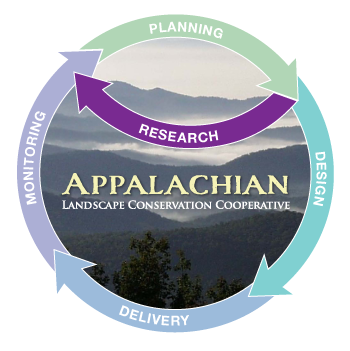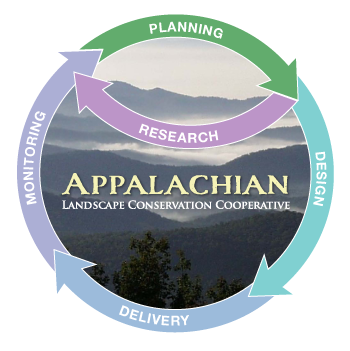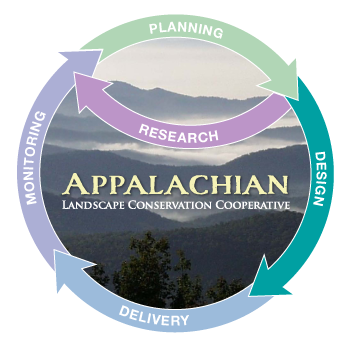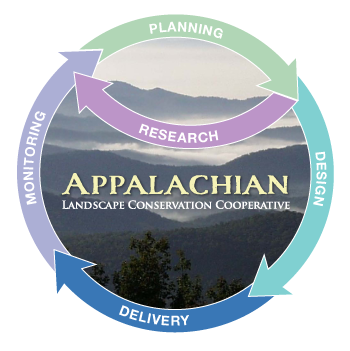Adopt a Conservation Framework
As part of the National Landscape Conservation Cooperative (LCC) Network, the Appalachian LCC has adopted its conservation framework to follow the U.S. Fish and Wildlife Service “Strategic Habitat Conservation” or SHC approach. The conservation framework is an adaptive management approach to help the conservation partners and communities access key science information and tools, and to work collaboratively to plan their work to deliver on-the-ground conservation to sustain and safeguard valued resources and fulfill trust responsibilities. The Appalachian LCC has designed this applcc.org site to function as a “Web-based Planning Tool or Platform” to deliver information, tools, and training, across the elements of the conservation framework:
Hover Over Image for More Information

Research
Research enters the conservation cycle or framework at two points: first as part of the planning if it is provides the basic or foundational research (i.e., studies of the biology, ecology, and threats to little-know resources.) As the science surrounding the conservation biology and management matures and advances around the conservation cycle. Research then re-enters the framework as Assumption-driven Research. This forces a re-examination of the presumed threats, response, concepts and underlying assumptions used in the design and delivery of conservation. It allows research and managers the ability to test the conservation plan and scientific understanding and feasibility to achieving desired objectives.

Planning
Planning is based on the underlying or foundational research and best available Data Delivered to the partners and communities to facilitate the identification of priority resources and set conservation objectives and targets. In the case of biological resources, Biological Planning targets are often quantitative -- such as population numbers or habitat targets. Social and cultural resources may also be part of the conservation planning and set more qualitative objectives. Conservation Planning at the large geographic scale and long time frame relevant to the LCCs seek to address such threats a climate change through the delivery and application of predictive tools and model results that help to describe the relationship between valued resources and the impacts of major climatic and land-use changes.

Design
Design requires the application of the best available tools and information formulate the conservation strategies necessary to achieve desired outcomes or targets. But under the changing conditions associated with major land-use and climate changes, Conservation Design at a landscape-level requires the integration of planning, partner-driven delivery, and outcome-based monitoring. In many cases a successful design will require conservation partnerships to engage and plan collectively with the broader society and non-traditional partners to reflect their values and needs, if the design is to be successful and sustain conservation outcomes.

Delivery
Delivery of conservation actions implement the strategies designed by the partners or community. The Landscape Conservation Cooperative (LCCs) partner organizations, agencies, and peoples Deliver on-the-ground conservation actions or monitoring. The role of the LCC is to support the collective membership by developing the tools, methodology, and assembling the information to guide the conservation delivery to achieve the conservation of the priority resources.

























